
Facsimile Magazine, published by Haoyan of America. Volume Two, Number One, 2008. ISSN 1937-2116.

Facsimile Magazine, published by Haoyan of America. Volume Two, Number One, 2008. ISSN 1937-2116.
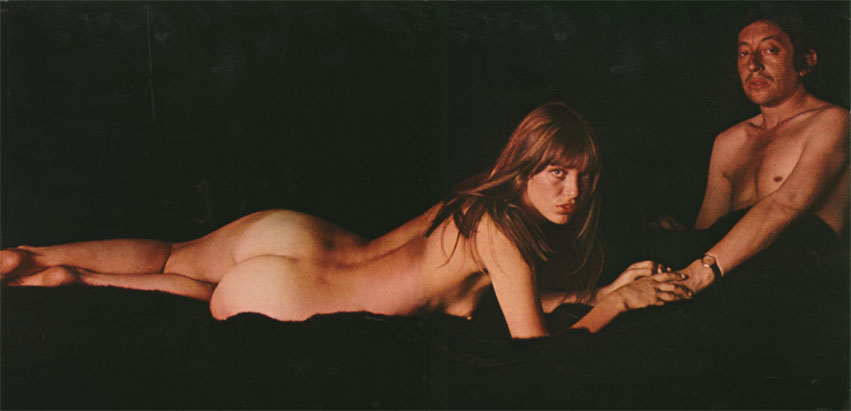
Interview by Eric Zamzow

EZ: Who are some of your artistic influences/heroes?
GB: Kerry James Marshall is the first that comes to mind. I love that he paints with acrylics and makes these extremely colorful figurative paintings that are beautiful to look at and also very political. Grant Wood is another artist who's changed the way I paint. He's best known for painting "American Gothic", but his work goes much deeper than that.
EZ: Who is your favorite NBA player?
GB: Dwayne Wade
EZ: When did you start painting?
GB: I can't remember exactly when, but I know I've always enjoyed it. Somewhere around 6th or 7th grade I got a book on Vincent Van Gogh as a gift and became obsessed with trying to paint exactly like he did.
EZ: Where do you see yourself as an artist in 10 years?
GB: I've always wanted to walk into a hotel room and see twin prints of my paintings over the bed. And in the bathroom. That would be satisfying.
EZ: Are you an animal lover?
GB: Yes, especially dogs... Especially my own dog Remy.
EZ: Do you believe in marriage?
GB: I'm not sure yet.
EZ: Are there any advantages to being a female artist in Los Angeles?
GB: I haven't noticed any yet. A lot of the shows I see here are pretty male-centric, but at the same time I don't feel like being a female artist in Los Angeles has put me at a disadvantage.
EZ: Do you think compact discs are shittier than cassette tapes?
GB: CDs take up less space. I like that. Although cassette tapes can't be scratched. So maybe they're a little better. It's a toss up.
EZ: What are your thoughts on the current state of the art scene in Los Angeles?
GB: There are a lot of opportunities for young or emerging artists to show in LA or get involved in the art scene. Most people I talk to who aren't familiar with LA can't understand why I would want to live here as a painter. They don't know that there's a fine art scene here at all. There are so many stores, cafes, and galleries that are constantly showing new work. There are definitely artists in LA who have styles that are copied to death, and that does become boring. But I'm very impressed with how open people here seem to be to new work for what it is, rather than just because they recognize a name.
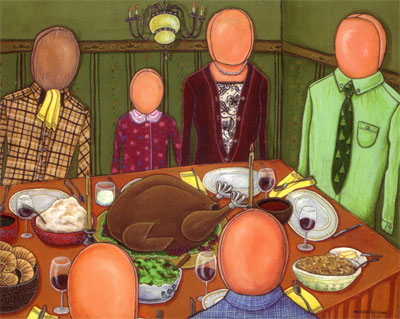

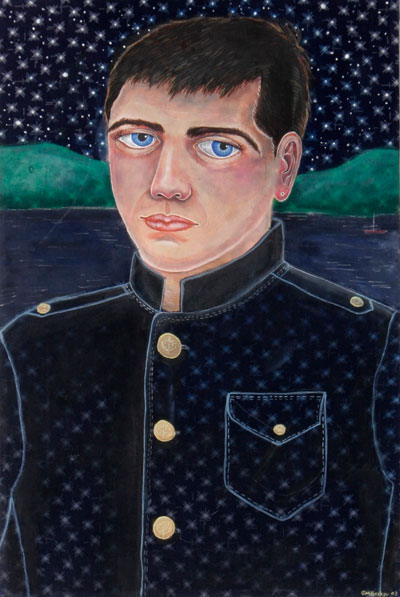
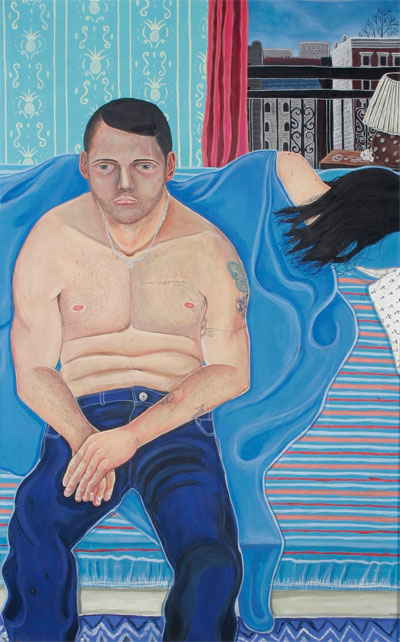
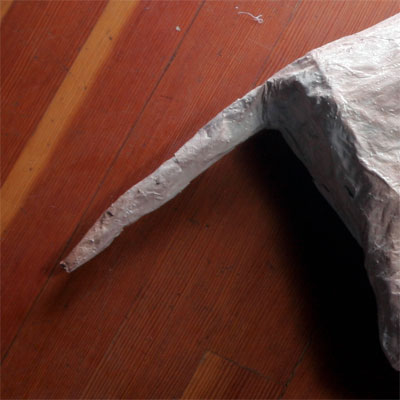

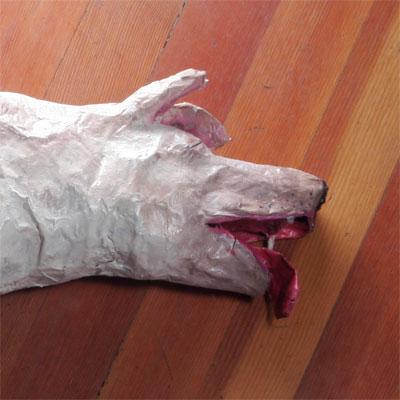
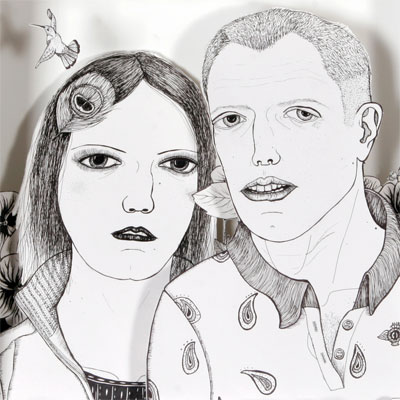
Gail M Boykewich was born and raised in northern New Jersey. In 2003 she earned a BFA in painting and sculpture from The School of the Art Institute of Chicago and moved to Los Angeles. Gail has been an active member of the Los Angeles art scene ever since, showing in popular venues such as the 2007 Spring Brewery Art Walk.
Gail's creations emerge in the form of acrylic portraits, paper-mache animals, hand sewn clothing and bags, and picture booklets. Her inspirations include classic portraiture, craft supply stores, product labels, and movie genres such as film noir and american melodrama.
By Woody Allen
It has been four weeks and it is still hard for me to believe Sandor Needleman is dead. I was present at the cremation and at his son's request, brought the marshmallows, but few of us could think of anything but our pain.
Needleman was constantly obsessing over his funeral plans and once told me, "I much prefer cremation to burial in the earth, and both to a weekend with Mrs. Needleman." In the end, he chose to have himself cremated and donated his ashes to the University of Heidelberg, which scattered them to the four winds and got a deposit on the urn.
I can still see him with his crumpled suit and grey sweater. Preoccupied with weighty matters, he frequently would forget to remove the coat hanger from his jacket while he wore it. I reminded him of it one time at a Princeton Commencement and he smiled calmly and said, "Good, let those who have taken issue with my theories think at least that I have broad shoulders." Two days later he was committed to Bellevue for doing a sudden back somersault in the midst of a conversation with Stravinsky.
Needleman was not a easily understood man, His reticence was mistaken for coldness, but he was capable of great compassion, and after witnessing a particularly horrible mine disaster once, he could not finish a second helping of waffles. His silence, too, put people off, but he felt speech was a flawed method of communication and he preferred to hold even his most intimate conversations with signal flags.
When he was dismissed from the faculty of Columbia University for his controversy with the then head of the school, Dwight Eisenhower, he waited for the renowned ex-general with a carpet beater and pelted him until Eisenhower ran for cover in a toy store. (The two men had a bitter public disagreement over whether the class bell signaled the end of a period or the beginning of another).
Needleman had always hoped to die a quiet death: "Amidst my books and papers like my brother Johann." (Needleman's brother had suffocated under a rolltop desk while searching for his rhyming dictionary).
Who would have thought that while Needleman would be watching the demolition of a building on his lunch hour, he would be tapped in the head by a wrecking ball? The blow caused massive shock and Needleman expired with a broad smile. His last, enigmatic words were, "No thanks, I already own a penguin."
As always, at the time of Needleman's death he was at work on several things. He was creating an Ethics, based on his theory that "good and just behavior is not only more moral but could be done by phone." Also, he was halfway through a new study of semantics, proving (as he so violently insisted) that sentence structure is innate but that whining is acquired. Finally, yet another book on the Holocaust. This one with cutouts. Needleman had always been obsessed by the problem of evil and argued quite eloquently that true evil was only possible if its perpetrator was named Blackie or Pete. His own flirtation with National Socialism caused a scandal in academic circles, though despite everything from gymnastics to dance lessons, he could not master the goose step.
Nazism was for him merely a reaction against academic philosophy, a position he always attempted to impress on friends and then would grab at their faces with feigned excitement and say, "Aha! Got your nose." It is easy to criticize his position on Hitler at first, but one must take into account his own philosophical writings. He had rejected contemporary ontology and insisted that man existed prior to infinity though not with too many options. He differentiated between existence and Existence, and knew he preferable, but could not remember which. Human freedom for Needleman consisted of being aware of the absurdity of life. "God is silent," he was fond of saying, "now if we can only get Man to shut up."
Authentic Being, reasoned Needleman, could only be achieved on weekends and even then it required the borrowing of a car. Man, according to Needleman, was not a "thing" apart from nature, but was involved "in nature," and could not observe his own existence without first pretending to be indifferent and then running around to the opposite end of the room quickly in hopes of glimpsing himself.
His term for the life process was Angst Zeit, loosely meaning Anxiety-Time and suggested man was a creature doomed to exist in "time" even though that was not where the action was. After much reflection, Needleman's intellectual integrity convinced him that he didn't exist, his friends didn't exist, and the only thing that was real was his IOU to the bank for six million marks. Hence, he was charmed by the National Socialist's philosophy of power, or as Needleman would put it, "I have the kind of eyes that are set off by a brown shirt." After it became apparent that National Socialism was just the type of menace that Needleman stood against, he fled Berlin. Disguised as a bush and moving sideways only, three quick paces at a time, he crossed the border without being noticed.
Everywhere in Europe Needleman went, students and intellectuals were eager to help him, awed by his reputation. On the run, he found time to publish Time, Essence, and Reality: A Systematic Reevaluation of Nothingness and his delightful lighter treatise, The Beast Places to Eat While in Hiding. Chaim Weizmann and Martin Buber took up a collection and obtained signed petitions to permit Needleman to emigrate to the United States, but at the time the hotel of his choice was full. With German soldiers minutes from his hideout in Prague, Needleman decided to come to America after all, but a scene occurred at the airport when he was overweight with his luggage. Albert Einstein, who was on that same flight, explained to him that if he would just remove the shoe trees from his shoes he could take everything. The two frequently corresponded after that. Einstein once wrote him, "Your work and my work are very similar although I'm still not exactly sure what your work it."
Once in America, Needleman was rarely out of public controversy. He published his famous, Non-Existenxe: What To Do f It Suddenly Strikes You. Also the classic work on linguistic philosophy, Semantic Modes of Non-Essential Functioning, which was made into the hit movie, They Flew By Night.
Typically, he was asked to resign from Harvard because of his affiliation with the Communist party. He felt only in a system with no economic inequality could there be real freedom and cited the model society an ant farm. He could observe ants for hours and used to muse wistfully, "They're truly harmonious. If only their women were prettier they'd have it made." Interestingly, WhenNeedleman was called by the House Un-American Activities Committee, he named names and justified it to his friends by citing his philosophy: "Political actions have no moral consequences but exist outside of the realm of true Being." For once the academic community stood chastened and it was not until weeks later taht the faculty at Princeton decided to tar and feather Needleman. Needleman, incidentally, used this same reasoning to justify his concept of free love, but neither of two young coeds would buy it and the sixteen-year-old blew the whistle on him.
Needleman was passionate about the halting of nuclear testing and flew to Los alamos, where he and several students refused to remove themselves from the site of a scheduled atomic detonation. As minutes ticked off and it became apparent the test would proceed as planned, Needleman was heard to mutter, "Uh-oh," and made a run for it. What the newspapers did not print was that he had not eaten all day.
It is easy to remember the public Needleman. Brilliant, committed, the author of Styles of Modes. But it is the private Needleman I will always fondly recall, the Sandor Needleman who was never without some favorite hat. Indeed, he was cremated with a hat on. At first, I believe. Or the Needleman who loved Walt Disney movies so passionately and who, despite lucid explanations of animation by Max Planck, could not be dissuaded from putting in a person-to-person call to Minnie Mouse.
When Needleman was staying at my house as a guest, I knew he liked a particular brand of tuna fish. I stocked the guest kitchen with it. He was too shy to admit his fondness for it to me, but once, thinking he was alone, opened every can and mused, "You are all my children."
At the opera in Milan with my daughter and me, Needleman leaned out of his box and fell into the orchestra pit. Too proud to admit it was a mistake, he attended the opera every night for a month and repeated it each time. Soon he developed a mild brain concussion. I pointed out that he could stop falling as his point has been made. He said, "No. A few more times. It's really not so bad."
I remember Needleman's seventieth birthday. His wife bought him pajamas. Needleman was obviously disappointed as he hinted for a new Mercedes. Still, it is the mark of the man that he retired to study and had his tantrum privately. He reentered the party smiling and wore the pajamas to the opening night of two short plays by Arabel.
By James Randerson, science correspondent

They are the intellectual elite, the brains the rest of us rely on to make sense of the universe and answer the big questions. But in a refreshing show of new year humility, the world's best thinkers have admitted that from time to time even they are forced to change their minds.
When tackling subjects as diverse as human evolution, the laws of physics and sexual politics, scientists and philosophers, including Steven Pinker, Daniel Dennett, Paul Davies and Richard Wrangham, all confessed yesterday to a change of heart.
The display of scientific modesty was brought about by the annual new year's question posed by the website edge.org, which drew responses from more than 120 of the world's greatest thinkers.
Edge's publisher, John Brockman, asked the intellectual cream what they had changed their mind about and why. "Science is based on evidence. What happens when the data change? How have scientific findings or arguments changed your mind?" said the brief.
A common theme in the responses is that what distinguishes science from other forms of knowledge and from faith is that new ideas can rapidly overturn old ones as new evidence emerges. So there's nothing to be ashamed about in admitting an intellectual switch. Some responses, such as Dennett's change of heart on how the mind works, resist paraphrasing in 100 words, but here is a selection of the rest.
Richard Wrangham, British anthropologist who studied under Jane Goodall. Now at Harvard University, his research includes primate behaviour and human evolution.
"I used to think that human origins were explained by meat-eating. After all, the idea that meat-eating launched humanity has been the textbook evolutionary story for decades, mooted even before Darwin was born.
"But in a rethinking of conventional wisdom I now think that cooking was the major advance that turned ape into human ... Cooked food is the signature feature of human diet. It not only makes our food safe and easy to eat, but it also grants us large amounts of energy compared to a raw diet, obviating the need to ingest big meals. Cooking softens food too, thereby making eating so speedy that as eaters of cooked food, we are granted many extra hours of free time every day."
Helena Cronin, philosopher at the London School of Economics and director of Darwin@LSE, a research group devoted to what Darwinism can tell us about human nature.
"I used to think that patterns of sex differences resulted mainly from average differences between men and women in innate talents, tastes and temperaments ... Add to this some bias and barriers - a sexist attitude here, a lack of childcare there - and the sex differences are explained. Or so I thought ... But they alone don't fully explain the differences ... Females are much of a muchness, clustering round the mean. But, among males, the variance - the difference between the most and the least, the best and the worst - can be vast.
"So males are almost bound to be over-represented both at the bottom and at the top. I think of this as 'more dumbbells but more Nobels'... Unfortunately, however, this is not the prevailing perspective in current debates, particularly where policy is concerned."
Mark Pagel, evolutionary biologist at Reading University. His research includes work on language and cultural evolution.
"Flawed as the old ideas about race are, modern genomic studies reveal a surprising, compelling and different picture of human genetic diversity. We are on average about 99.5% similar to each other genetically. This is a new figure, down from the previous estimate of 99.9%. To put what may seem like minuscule differences in perspective, we are somewhere around 98.5% similar, maybe more, to chimpanzees, our nearest evolutionary relatives.
"The new figure for us, then, is significant. It derives from among other things, many small genetic differences that have emerged from studies that compare human populations ... Like it or not, there may be many genetic differences among human populations - including differences that may even correspond to old categories of "race" - that are real differences in the sense of making one group better than another at responding to some particular environmental problem.
"This in no way says one group is in general "superior" to another ... But it warns us that we must be prepared to discuss genetic differences among human populations.
Steven Pinker, leading psychologist and language expert at Harvard University. Author of The Language Instinct and The Blank Slate.
"I've had to question the overall assumption that human evolution pretty much stopped by the time of the agricultural revolution ... New [laboratory] results have suggested that thousands of genes, perhaps as much as 10% of the human genome, have been under strong recent selection, and the selection may even have accelerated during the past several thousand years ... If these results hold up, and apply to psychologically relevant brain function ... then the field of evolutionary psychology might have to reconsider the simplifying assumption that biological evolution was pretty much over and done with 10-000-50,000 years ago."
Laurence Krauss, physicist at Case Western Reserve University and prominent opponent of the Intelligent Design movement. His books include The Physics of Star Trek.
"I was relatively certain that there was precisely enough matter in the universe to make it geometrically flat ... according to general relativity [geometrically flat] means there is a precise balance between the positive kinetic energy associated with the expansion of space, and the negative potential energy associated with the gravitational attraction of matter in the universe so that the total energy is precisely zero ... We are now pretty sure that the dominant energy-stuff in our universe isn't normal matter, and isn't dark matter, but rather is associated with empty space! And what is worse (or better, depending upon your viewpoint) is that our whole picture of the possible future of the universe has changed. An accelerating universe will carry away almost everything we now see, so that in the far future our galaxy will exist alone in a dark, and seemingly endless void. And that is what I find so satisfying about science ... that the whole community could throw out a cherished notion, and so quickly! That is what makes science different than religion."
Philip Campbell, editor-in-chief of the leading scientific journal Nature
"I've changed my mind about the use of enhancement drugs by healthy people. A year ago, if asked, I'd have been against the idea, whereas now I think there's much to be said for it. The ultimate test of such a change of mind is how I'd feel if my offspring (both adults) went down that road, and my answer is that with tolerable risks of side effects and zero risk of addiction, then I'd feel OK if there was an appropriate purpose to it ... Research and societal discussions are necessary before cognitive enhancement drugs should be made legally available for the healthy, but I now believe that that is the right direction in which to head.
Alan Alda, perhaps best-known as Hawkeye in the 70s series MASH. He now hosts Scientific American Frontiers on US television.
"Until I was 20 I was sure there was a being who could see everything I did and who didn't like most of it. He seemed to care about minute aspects of my life, like on what day of the week I ate a piece of meat. And yet, he let earthquakes and mudslides take out whole communities, apparently ignoring the saints among them who ate their meat on the assigned days. Eventually, I realised that I didn't believe there was such a being ... I still don't like the word agnostic. It's too fancy. I'm simply not a believer."
From the 1970 edition of Time Life Books' Nature/Science Annual
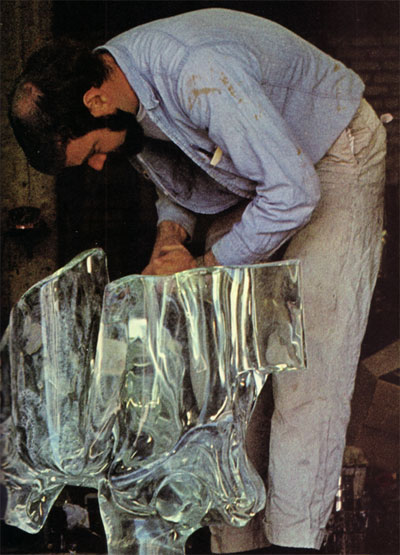
In the minds of many people, art and science are as incompatible as chalk and cheese. Yet in 1969 their relationship - long a tacit liaison - was moving with increasing swiftness toward the status of a former merger. A clear example is the sculpture of Bruce Beasley, a 29-year-old California-based artist who pioneered a new chemical technique while creating a sculpture made of acrylic. Casting it in the thousand-pound forms Beasley wanted defeated him, and chemists said it was impossible: in changing from a liquid to a solid, the material generates heat that destroys it. Beasley tackled the chemical problems himself and came up with a way to control the destructive heat. The solution eventually enabled him to cast a 12,000-pound acrylic sculpture commissioned for $50,000 by the state of California. Not only did Beasley achieved his artistic goal: his new knowledge is in demand - from the very engineers who told him it could not be done.
As one who has made science serve the ends of art, Beasley belongs to a growing band. One group of artists, entranced by television's cathode-ray tube, has created brilliant exercises in "silent TV". A young Japanese has built an "environmental work" that employs interlocking patterns of different-colored laser beams. With the help of technologists other artists have composed works that move and glitter at the sound of a voice. And the computer, tool of mathematicians, tax collectors and election forecasters, has become a palette for "painting" geometric fantasies more complex than the great cathedral windows of the Gothic Age, and a tool for shaping a three-ton metallic structure. Such collaborations have aroused so much interest that maintaining communications between artists and technologists has become a full-time job for a scientist named Billy Klüver. Co-founder with painter Robert Rauschenberg of a group called Experiments in Art and Technology (E.A.T.), Klüver, once a Bell Labs physicist, now concentrates on running a nationwide network of E.A.T. chapters dedicated to keeping artists informed of the creative opportunities opened by modern technology.
Bruce Beasley loads his backyard pressure oven with a mold full of acrylic and adjusts controls to regulate the temperature and pressure of the process that slowly transforms fluid plastic into solid. More limpid than glass, the resulting abstract sculptures capture and refract light in effects that vary with the angle from which they are seen and with the time of day.


Artists have developed a number of adaptations of television technology that have led to bizarre visual effects. One, which uses a transistorized contraption of Rube Goldberg complexity, is Thomas Tadlock's "Archetron." The device, which cost $10,000 to build, scrambles a black-and-white television show to produce an ever-changing sequence of brilliant kaleidoscopic patterns. The artist manipulates knobs and switches to scramble a TV program into the different patterns on the small screens at left of console; projected through color filters, these patterns are reassembled in color into kaleidoscope seen in the top screen. Explaining the rationale behind his creation, Tadlock says he found in the cathode-ray tube a way "to make the viewer develop a new way of seeing."
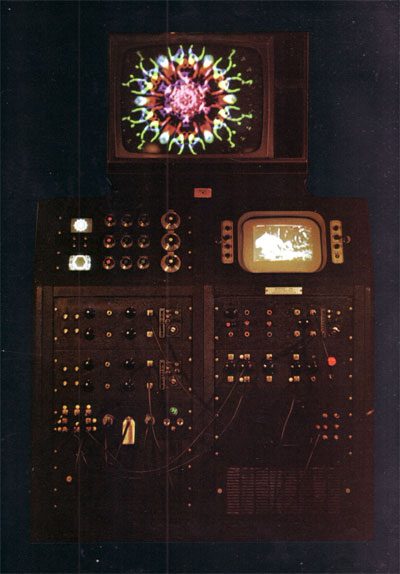
Another artist, nuclear physicist Earl Reiback, dismantled a TV, stripping the image-reflecting phosphor from the screen. Reiback splashed the inside of the tube with phosphor paints and inserted a piece of fan-shaped painted metal at right angles to the tube face. The TV signal's electron beam scan sweeps this inner "screen," and the viewer "sees" the electrons as bursts of color shooting toward the tube face.
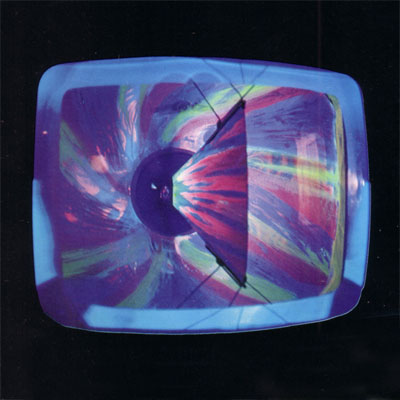
A viewer waves his hands to produce the overlapping, multi-chrome effects in Nam June Paik's "Participation TV." The korean-born artist's work consists of a closed-circuit system of three video cameras. Each receives images in a different color (red, blue and yellow) and from a slightly different angle. Their separate images appear on a color set where the viewer sees his gestures in an overlapping pattern.

Japanese artist Keiji Usami combined one of man's oldest light manipulating devices, the mirror, with one of his newest, the laser, in the work he calls "Laser:Beam:Joint." The artist's sketch plan shows how a blue laser beam and a red laser beam are reflected from strategically placed mirrors in the five green plastic panels that define the work's 15-by-18-foot area - which can be entered by the viewer (the lasers used are harmless, low frequency beams). Each panel is sculpted with two over-lapping figures of running men. One-inch mirrors, set into the panels where the figures intersect, bounce the laser beams back and forth among the outlined men, creating what Usami describes as a network of symbolic relationships.
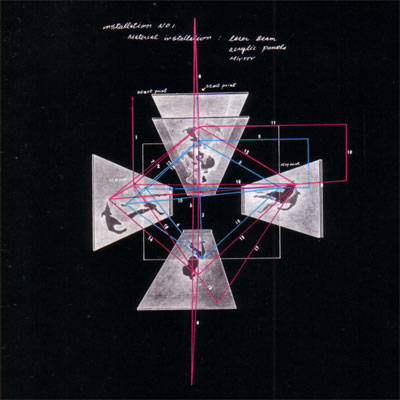
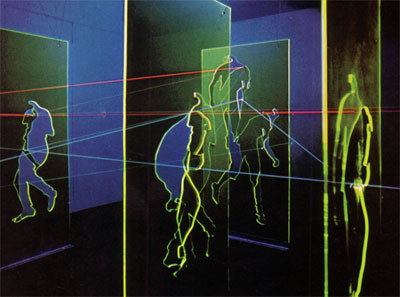

Turning sound into moving patterns of light is a technique that is attracting increasing numbers of artists. The three patterns below are created by voice: Nam June Paik rewired a color TV set so that its cathode-ray tube, activated by two microphones, turns the energy of sound waves into light waves. One mike picks up low tones to control the width of the bright lines, the other receives the high notes and regulates the height of the lines.

Also dependent on talkative viewers is Robert Rauschenberg's "Soundings." Activated by vocal frequencies converted to electronic impulses, lights turn on and disclose layers of images of a plain chair. The pictures are silk-screened onto Plexiglas plates set behind reflecting panels that hide the exhibit until the viewer speaks up. The tone and range voices picked up by microphones control the brilliance of the lamps that illuminate the images.
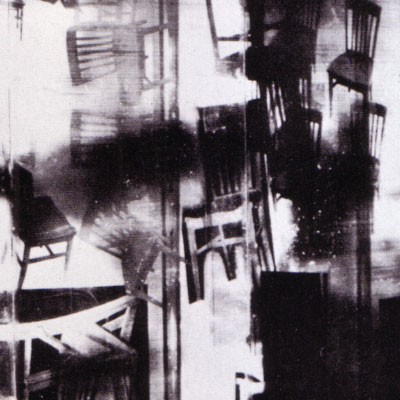
Images as intricate as jewel-like as stained-glass windows are the creations of John Mott-Smith. A physicist at the Air Force Cambridge Research Laboratories. Dr. Mott-Smith is also a leading practitioner in the young and growing field of computer art. He makes his pictures by programming a computer to move points of light across an oscilloscope screen in various patterns. Using time-exposure and multiple-exposure photography, he records the intricate movements of light on photographic film, using filters on his camera to vary the colors. As an artist, physicist Mott-Smith is intrigued by the fact that precision implicit in his creative tools does not make for predictability. "Although I set the program," he says, "it's hard to figure out what I will see. The, as I watch the screen, a sort of relationship develops between me and the computer, and the art takes shape."
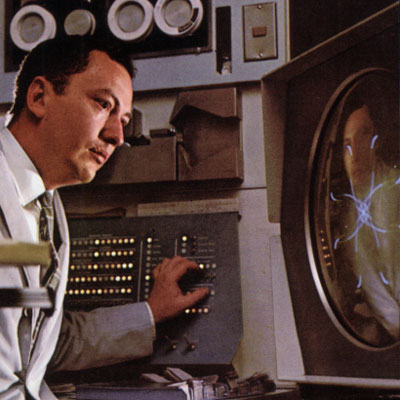


Computer-assisted sculpture is the invention of Alfred Duca, an artist associated with M.I.T. To construct his three ton, seven-foot-wide creation, "Steel Spheroid," which stands in a mall of the Government Center Complex in Boston, Duca welded together the 80 concentric serrated rings of steel. The exacting task of cutting the steel in uniform zigzags would have taken Duca hundreds of man hours to perform by himself. By programming a computer to automate the machine that activated the four cutting torches, Duca not only saved time but achieved mathematical precision.
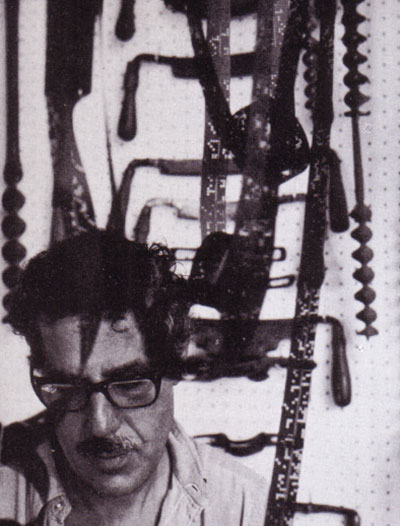
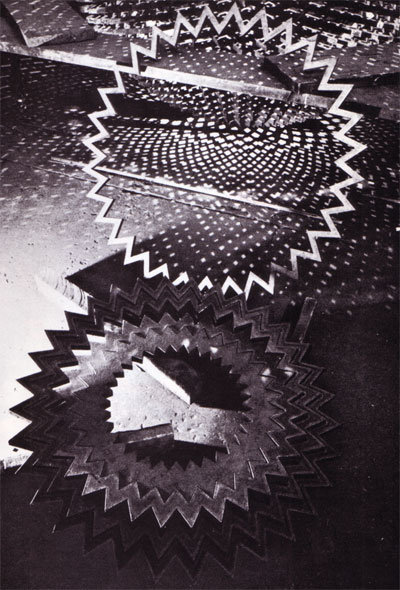
Do you wish to work with a computer? Would you reside at a computer center if the opportunity arose? Do you need to operate in an industrial situation to execute your work? Have you ever collaborated with a technical person?
These are sample queries in a questionnaire mailed to more than 2,000 artist members of an organization called Experiments in Art and Technology (E.A.T.). Founded in 1966 by Bell Labs physicist Billy Klüver and the painter Robert Rauschenberg, E.A.T. aims at fostering a "civilized collaboration between groups developing in isolation, artists and scientists." Says Klüver, "We live in a crack between the artist and engineer. We help to overcome the physical barriers an artist has in obtaining what he needs for the end result: the materials for his work, and the engineering know-how to bring it about."
Group activities are nothing new for artists. There have been dozens of organized "movements" - the Futurists, Surrealists, and so on - in which artists band together, held meetings, issued manifestoes and energetically promoted their theories. E.A.T., however, espouses no particular theory; instead, it seeks only to inform artists of new creative avenues afforded by technology - and to help them solve problems involving expertise they lack or materials they cannot find. "For example," says Klüver, "an artist may want a certain type of steel - but it's only sold in two-ton lots and he wants maybe half a ton. We can possibly help."
The concept has proved so popular that over 40 chapters of E.A.T. have sprung up in cities across the country. E.A.T. has staged museum exhibitions of the results of artist-scientist collaboration, and the Pepsi-Cola Pavilion at the 1970 Japan World Exposition in Osaka will be a spectacular showplace for E.a.t. (The plaza surrounding the pavilion will be populated with man-sized white domes that move slowly, changing direction when touched and emit sounds.)
Inspired by the success of E.A.T., the Los Angeles County Museum of Art has taken a daring plunge into art-technology matchmaking. The museum's curator, Maurice Tuchman, has arranged for artists to spend several months in the plants and laboratories of more than 20 California industries. With corporate funds, materials and technical advice, the artists-in-residence will work on projects of their own choice; the results will go on public view in the spring o 1970. Among the participants is the noted pop-artst Claus Oldenburg, who has taken up residence at Walt disney Productions. Andy Warhol is putting his talents to work on holography - three-dimensional laser photography - under guidence of RCA and Ampex Corporation. The French sculptor-painter Jean Dubuffet, who works extensively with concrete sculptures, is using the facilities of the American Cement Corporation to build a monumental creation; company executives are impressed with Dubuffet's "very scientific approach to problem solving" and feel the artist may give them insight into their own problems. The outcome of this art-technology merger is unpredictable, but curator Tuchman is optimistic. "We feel that if the best artists are exposed to the sophisticated techniques of industry, something will come out of it. Both artists and corporations may gain something from each other. An important result, we hope, will be the production of very good and original art."
In the same spirit that has impelled a few companies to move toward a true collaboration with artists, some technological schools, notably the Massachusetts Institute of Technology, are also beginning to see the benefits of bringing scientists and artists together. When M.I.T. recently opened its Center for Advanced Visual Studies, "ecumenical sparks" - in the words of the Institute's chairman - were immediately set off. Artists and engineers at M.I.T. talk of blending skills to construct epic projects: huge reflectors that will float among clouds and sculptures as big or bigger than the Empire State Building.

Artist Robert Whitman inspects a concave mirror he designed with the help of John Forkner, an optical engineer for the space and defense divison of Philco-Ford in California. The two men designed teh mirror as part of a complex optical art exhibit for the 1970 Japan World Exposition at Osaka.
